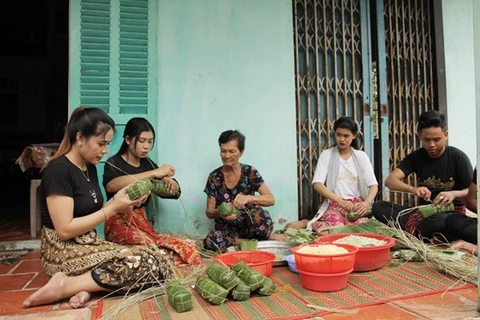Kien Giang (VNA) - The lives of ethnic Khmer people living in Kien Giang have improved significantly after the province efficiently implemented local and central government support policies for them in recent years.
The Mekong Delta province has 56,800 Khmer households with 242,602 members, or 13.4 percent of its population and the third largest number in the delta after Soc Trang and Tra Vinh provinces.
As part of the support policies it has provided them with easy loans, free health insurance, clean water, and power, and built other infrastructure facilities, according to the provincial Committee for Ethnic Minority Affairs.
Credit programmes from local and central governments have provided 211 billion VND (9.1 million USD) to 18,128 Khmer families for doing agriculture or business since 2014.
The province has also allotted housing lands to 635 poor households and provided free health insurance for 424,993 people.
The number of Khmer households with access to clean water has increased from 77.9 percent in 2014 to 88.3 percent now, while almost all have access to power compared to less than 80 percent in 2014.
Danh Phuc, head of the Committee for Ethnic Minority Affairs Committee, said with the support of local and central government support, Khmer farmers have switched from mostly growing rice to other high-value crops, vegetables and fruits besides livestock.
Many have also begun to work in industrial parks, he said.
With the implementation of the support policies, the number of poor households has reduced from 10,346 in 2015 to 4,855 now for a 7.9 percent rate, according to the committee.
Localities in the province have implemented several sustainable poverty reduction models and included Khmer households in them.
They include raising cows, buffaloes, pigs, eels, and fish, growing vegetables and farming rice and shrimp by turns in the same fields.
In Vinh Thuan district, local authorities have introduced several effective farming models to the Khmer like breeding mud crabs and shrimp in the same pond, raising giant river prawns and rice-shrimp farming.
The rice - shrimp model has helped improve the incomes of the Khmer since most farmed only one or the other earlier.
In Kien Lương district, the Duong Hoa Commune Farmers Association has taught Khmer farmers new farming models to improve incomes in recent years.
They include switching to fish, mud crabs, black tiger shrimp, buffaloes, and ducks on low-yield rice fields.
Duong Van La, a farmer in Duong Hoa’s Ta Sang hamlet, has switched from rice to freshwater fish after the association gave him training.
He now breeds snakehead fish, yellow bighead catfish and climbing perch, he said.
“I harvest two to three crops a year and earn 50 million VND (2,160 USD)./.
The Mekong Delta province has 56,800 Khmer households with 242,602 members, or 13.4 percent of its population and the third largest number in the delta after Soc Trang and Tra Vinh provinces.
As part of the support policies it has provided them with easy loans, free health insurance, clean water, and power, and built other infrastructure facilities, according to the provincial Committee for Ethnic Minority Affairs.
Credit programmes from local and central governments have provided 211 billion VND (9.1 million USD) to 18,128 Khmer families for doing agriculture or business since 2014.
The province has also allotted housing lands to 635 poor households and provided free health insurance for 424,993 people.
The number of Khmer households with access to clean water has increased from 77.9 percent in 2014 to 88.3 percent now, while almost all have access to power compared to less than 80 percent in 2014.
Danh Phuc, head of the Committee for Ethnic Minority Affairs Committee, said with the support of local and central government support, Khmer farmers have switched from mostly growing rice to other high-value crops, vegetables and fruits besides livestock.
Many have also begun to work in industrial parks, he said.
With the implementation of the support policies, the number of poor households has reduced from 10,346 in 2015 to 4,855 now for a 7.9 percent rate, according to the committee.
Localities in the province have implemented several sustainable poverty reduction models and included Khmer households in them.
They include raising cows, buffaloes, pigs, eels, and fish, growing vegetables and farming rice and shrimp by turns in the same fields.
In Vinh Thuan district, local authorities have introduced several effective farming models to the Khmer like breeding mud crabs and shrimp in the same pond, raising giant river prawns and rice-shrimp farming.
The rice - shrimp model has helped improve the incomes of the Khmer since most farmed only one or the other earlier.
In Kien Lương district, the Duong Hoa Commune Farmers Association has taught Khmer farmers new farming models to improve incomes in recent years.
They include switching to fish, mud crabs, black tiger shrimp, buffaloes, and ducks on low-yield rice fields.
Duong Van La, a farmer in Duong Hoa’s Ta Sang hamlet, has switched from rice to freshwater fish after the association gave him training.
He now breeds snakehead fish, yellow bighead catfish and climbing perch, he said.
“I harvest two to three crops a year and earn 50 million VND (2,160 USD)./.
VNA
























